Posted by Elena del Valle on September 30, 2008
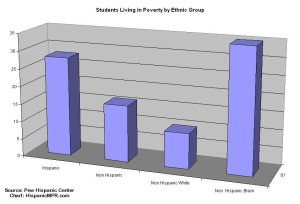
Click on image to enlarge
Between 1990 and 2006 the Hispanic student population in the public school system nationwide nearly doubled. Hispanic students represent 60 percent of the overall growth in public school enrollments for that time period. About 20 percent of all public school students today are Latino; that’s 10 million Hispanic students attending public schools.
In addition, Hispanics are already the largest minority group in the public schools in 22 states. The growth is particularly evident in states which have traditionally had large Latino populations. For example, while in 1990 Latinos represented 36 percent of the public school population in California, by 2006 50 percent of all students in that state were Latino.
In 2006, in Arizona, Mexico and Texas more than 40 percent of enrollments were of Latino students. That same year, in Nevada, Colorado, Illinois, Florida and New York between 20 percent and 40 percent of students were Hispanic.
According to newly released U.S. Census Bureau demographic estimates, Hispanic student enrollment is likely to continue to grow for many years. Researchers believe that by 2050 there will be more Hispanic children than non Hispanic white children.
Find out what multicultural kids across America think
Listen to Michele Valdovinos, SVP, Phoenix Multicultural in
“Marketing to Multicultural Kids” audio recording

Michele Valdovinos gives a presentation and participates in an extended Q&A discussion about multicultural children based on a Phoenix Multicultural and Nickelodeon study of 1,300 multicultural children in 16 United States markets.
Find out about
• The Phoenix Multicultural Kids Study
• Relationship between children and their context
• Issues relating to family, technology and media, diversity, buying power, relationships in household, self perception, values, acculturation, cultural heritage, frequency of media activity, income and spending, brand preferences, the American Dream
• How many billions of dollars buying power multicultural kids children have
• Children’s spending attitudes, habits by ethnicity
• How much money a year Hispanic kids have available to spend
• Types of products Hispanic kids buy
Click here for information on “Marketing to Multicultural Kids” audio recording
A recent Pew Hispanic Center report indicate most (84 percent) Latino public school system students are United States born; seventy percent of Latino students speak a foreign language at home; 18 percent of Latino students have poor English language skills; and only slightly more than half (57 percent) of Latino children live in a household with both parents compared with 69 percent of non Hispanic white students and 30 percent of black students.
Also, 71 percent of United States born students of immigrant parents live with both of their parents compared with 58 percent of foreign born students and 48 percent of students born in the United States of native parents.
Twenty-eight percent of Latino students are poor compared with 16 percent of non Hispanic students, 35 percent of non Hispanic black students and 10 percent of non Hispanic white students. At the same time, foreign born Hispanic children are more likely to live in poverty than United States born Latinos, 35 percent and 27 percent respectively.
The Pew Hispanic Center, an initiative of the Pew Research Center, is a non-partisan, non-advocacy research organization based in Washington, D.C. The Pew Hispanic Center is funded by The Pew Charitable Trusts.
Target Latinos effectively by anticipating changes in the market with
“Hispanic Projections with 2007-08 update” audio recording

Presenter Roger Selbert, Ph.D.
Find out
- About Latino buying power growth in the future
- How Latino market growth compares with other markets in the U.S.
- What drives the rise of Latino economic clout
- Who should target the Latino market
- What is the size of the Hispanic affluent market
- If the luxury Latino market is growing
Stay ahead of your competition with “Hispanic Projections”
Posted by Elena del Valle on September 29, 2008

Julio Stieffel, director, BuscAbogados.com
Photo: BuscAbogados.com
A podcast interview with Julio Stieffel, director, BuscAbogados.com is available in the Podcast Section of Hispanic Marketing & Public Relations, HispanicMPR.com. During the podcast, Julio discusses the new website with Elena del Valle, host of the HispanicMPR.com podcast.
Julio founded Americas Rep International, an international consulting firm specializing in the Latin American market. He graduated from the University of Miami with a degree in Inter-American Studies. Julio brings nearly 30 years of international sales and marketing intelligence and experience to the BuscAbogados.com team.
To listen to the interview, scroll down until you see “Podcast” on the right hand side, then select “HMPR Julio Stieffel,” click on the play button below or download the MP3 file to your iPod or MP3 player to listen on the go, in your car or at home. To download it, click on the arrow of the recording you wish to copy and save to disk. The podcast will remain listed in the September 2008 section of the podcast archive.
Reach Hispanics online today with
“Marketing to Hispanics Online” audio recording
Identifying and characterizing the booming Hispanic online market


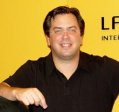
Joel Bary, Alex Carvallo and Matias Perel
Find out about
• The 16 million Latino online users
• Latino online users by gender
• What they do online
• Their language preferences
• How to reach Hispanic urban youth online
• What affects their online behavior
• What influences their purchases
Click here for information about “Marketing to Hispanics Online”
Posted by Elena del Valle on September 23, 2008


Scenes from “Shame,” a Pine-Sol television ad in Spanish
Photos, video: Dieste
Pine-Sol, with the help of Dallas ad agency Dieste, began airing a Spanish language television commercial in October 2007 that recently won the agency national recognition. Scroll down to see the ad in Spanish.
The 30-second ad features a frisky young couple at the family dinner table. The young lady plays footsies under the table during the meal. Her activities are discovered when the young man gets up and dirty footprints can be seen all over the front of this pants revealing to everyone’s horror that the floors are dirty.
The ad required two months to produce and was completed September 2007. It aired nationally on Univision and Telemundo.
“Best in Class Hispanic Strategies” audio recording


Presenters Carlos Santiago and Derene Allen
-
Find out what makes 25 percent of the top 500 Hispanic market advertisers out perform the remaining companies
-
Discover what questions to ask, steps to take to be a Best in Class company
Click here for more about “Best in Class Hispanic Strategies” audio recording
Dieste received an award for the ad at this year’s Creativity Awards, an international advertising and graphic design competition. The 38th Annual Creativity Awards received a record 2,800 entries from 44 countries. The competition showcases work from around the globe.
“Dieste had a very strong showing with six trophies secured this year, which compares very well against U.S. and Latin American agencies that entered the competition,” said Kathleen Ritchie, spokesperson of Creativity Awards.

Aldo Quevedo, president, Dieste
“This year the creative work from the agency has received great recognition and we are proud of having strong showings, including the most awarded Hispanic agency at El Sol in San Sebastian, and a Short List recognition in Cannes,” said Aldo Quevedo, president of Dieste.
Dieste is a Hispanic advertising and marketing agency that offers integrated communications and business solutions, including strategic planning, advertising, direct-response marketing, experiential and promotional capabilities, media planning and buying capabilities, digital media and public relations services.
Make Latinos loyal to your brand
Listen to Author Isabel Valdes in
“Hispanics Customers for Life” audio recording

Isabel Valdes gives a presentation and participates in an extended Q&A discussion about
• Immigrants adaptation to their new country, culture
• Latino cultural values and their role
• Case studies, insights on Latinos as long term customers
• Acculturation
• Latinos and how they adapt to their host country
• Adaptation, assimilation
• Difference between assimilation and acculturation
Click here for information on Hispanic Customers for Life audio recording
Posted by Elena del Valle on September 18, 2008
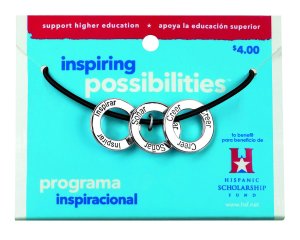
Payless ShoeSource Trinity necklace
Photos: Payless ShoeSource
To celebrate Hispanic Heritage Month, Payless ShoeSource is launching the Payless Inspiring Possibilities scholarship program to raise funds for the Hispanic Scholarship Fund (HSF). Beginning September 2008, 650 Payless stores nationwide and the company website began offering a limited edition Trilogy necklace. The black corded necklace with three hoops and inspirational words in English and Spanish: Believe/Creer, Dream/Soñar, and Inspire/Inspirar, sells for $4.

Close up of Payless Trinity necklace
As part of the project, Payless will donate 100 percent of the net profits from the necklace sales to the HSF, making a minimum donation of $35,000. Company representatives expect to distribute a minimum of a dozen $2,500 scholarships as a result of the new initiative.
“Youth and education are critical to the future of our nation,” said LuAnn Via, president and chief executive officer of Payless. “Our efforts in September are focused on supporting Hispanic youth with our Payless Inspiring Possibilities program. The unique, limited-edition Trilogy necklace is available for only $4, a price point accessible to so many. Together, we are truly celebrating Hispanic Heritage Month and benefiting young Hispanics with strong opportunities for higher education and to help them achieve their goals and make their dreams come true.”
Find out what multicultural kids across America think
Listen to Michele Valdovinos, SVP, Phoenix Multicultural in
“Marketing to Multicultural Kids” audio recording

Michele Valdovinos gives a presentation and participates in an extended Q&A discussion about multicultural children based on a Phoenix Multicultural and Nickelodeon study of 1,300 multicultural children in 16 United States markets.
Find out about
• The Phoenix Multicultural Kids Study
• Relationship between children and their context
• Issues relating to family, technology and media, diversity, buying power, relationships in household, self perception, values, acculturation, cultural heritage, frequency of media activity, income and spending, brand preferences, the American Dream
• How many billions of dollars buying power multicultural kids children have
• Children’s spending attitudes, habits by ethnicity
• How much money a year Hispanic kids have available to spend
• Types of products Hispanic kids buy
Click here for information on “Marketing to Multicultural Kids” audio recording
“We are pleased that Payless has taken a leadership role in providing resources and opportunities to support our future leaders,” said Gary Jimenez, regional vice president of the Hispanic Scholarship Fund.

Spanish language necklace – click on image to enlarge
“HSF provides the Hispanic community with more college scholarships than any other organization,” said Gaby Alban, Hispanic spokesperson for Payless. “We at Payless are proud and honored to partner with the HSF in supporting their mission to double the rate of U.S. Hispanics earning college degrees.”
Payless ShoeSource, Inc., a unit of Collective Brands, Inc., is one of the largest specialty family footwear retailers in the United States. As of the end of first quarter 2008, the company operated more than 4,500 stores. Since 2004, Payless has established formal programs to support important causes by selling on-trend items and making them accessible with affordable price points at the same time donating 100 percent of the net profits from the sales of the item to the cause.
Founded in 1975 as a not-for-profit, the HSF is a Latino scholarship organization. During the 2007-2008 academic year, HSF awarded almost 4,100 scholarships exceeding $26.7 million.
“Moving Beyond Traditional Media Measurement: measuring conversations and social media” audio recording

Presenter Katie Delahaye Paine, founder, KDPaine & Partners
Find out about
- Issues affecting online public relationships today
- Testing relationships as part of a survey
- Measuring ethnic group relationships
- Measuring foreign language communications in a similar ways to English
- Biggest challenges measuring conversations and social media
- Measuring online relationships with little or no money
Click here for information on “Moving Beyond Traditional Media Measurement”
Posted by Elena del Valle on September 11, 2008

Ernie Allen, president and CEO, NCMEC
Photo: National Center for Missing & Exploited Children
In an effort to reach Spanish dominant communities with a strong online presence, the NetSmartz Teens website NSTeens.org, an Internet safety resource of the National Center for Missing & Exploited Children (NCMEC) with funding support from Sprint, recently added Spanish language information to the site’s online materials.
Project leaders relied on research from the Pew Internet and American Life Project that indicates 76 percent of bilingual Latinos and 32 percent of Spanish-dominant Latinos use the Internet. The new Spanish translations are designed to reach this audience with online safety resources using Web comics, animated videos and activity cards.
The website, created by staff at NCMEC’s NetSmartz Workshop, was designed to educate tech oriented youth about the potential risks they may encounter online and the importance of following safe behavior on the Internet. Now in its second year, the program’s online resources pages target tweens (youth ages eight to 12), their parents, guardians and educators with information about cyberbullying and social networking.
“We know that talking about the potential risks our children face online can be difficult for everyone, but education is critical to all of our online safety efforts,” said Ernie Allen, president and chief executive officer, NCMEC. “No audience should be overlooked, and we are grateful to Sprint for sharing our commitment to reaching as many people as possible with tools they can use to make their families safer.”
To promote the Spanish language content the National Center for Missing and Exploited Children is planning an online outreach campaign targeted at various websites and parenting publications with banner ads in Spanish directed at children and parents. Additionally, Sprint plans to reach out to local Hispanic Chambers of Commerce of which the company is a member requesting that the organizations notify their members about the availability of the Spanish language information.
Sprint committed $395,000 for the second year of its partnership with NCMEC. The funds are earmarked to enhance the project and develop new content. According to promotional materials, all existing content is available in Spanish in the En Español section of the website. Organizers also plan future content in the coming months in Spanish and English on some of the potential future consequences of online actions and the issues associated with online gaming.
Find out what multicultural kids across America think
Listen to Michele Valdovinos, SVP, Phoenix Multicultural in
“Marketing to Multicultural Kids” audio recording

Michele Valdovinos gives a presentation and participates in an extended Q&A discussion about multicultural children based on a Phoenix Multicultural and Nickelodeon study of 1,300 multicultural children in 16 United States markets.
Find out about
• The Phoenix Multicultural Kids Study
• Relationship between children and their context
• Issues relating to family, technology and media, diversity, buying power, relationships in household, self perception, values, acculturation, cultural heritage, frequency of media activity, income and spending, brand preferences, the American Dream
• How many billions of dollars buying power multicultural kids children have
• Children’s spending attitudes, habits by ethnicity
• How much money a year Hispanic kids have available to spend
• Types of products Hispanic kids buy
Click here for information on “Marketing to Multicultural Kids” audio recording
“We are so pleased to be continuing our partnership with NCMEC to fund NSTeens, particularly now that we’re able to bring these materials to an even wider audience,” said Debby Ballard, director of Community Relations for Sprint. “At Sprint, we’re committed to finding ways that we can all work together to provide the best opportunities for our children. The Internet is an important tool from which many youth can benefit but it’s also a tool that’s seeing an increasing number of dangers. NSTeens.org gives our children the information they need to start making smarter choices online and in the real word, in ways that are both fun and meaningful for them.”
NSTeens.org is part of Sprint’s 4NetSafetySM program which offers online safety information for children, especially tweens, as well as teachers, parents, guardians and other adults. Sprint Project Connect provides all 4NetSafety funding. Sprint Project Connect is Sprint’s phone recycling program which accepts wireless phones and accessories of any make and model, and from any carrier.
The National Center for Missing & Exploited Children is a 501(c)(3) nonprofit organization. Since it was established by Congress in 1984, the organization’s toll-free 24-hour national missing children’s hotline has handled more than 2.3 million calls. It has assisted law enforcement in the recovery of more than 128,750 children. The organization’s CyberTipline has handled more than 600,000 reports of child sexual exploitation and its Child Victim Identification Program has reviewed and analyzed more than 14,750,000 child pornography images and videos.
Sprint Nextel offers wireless and wireline communications services to consumers, businesses and government users. Sprint Nextel has two wireless networks serving nearly 52 million customers at the end of the second quarter 2008; industry-leading mobile data services; instant national and international push-to-talk capabilities; and a global Tier 1 Internet backbone.
Reach Hispanics online today with
“Marketing to Hispanics Online” audio recording
Identifying and characterizing the booming Hispanic online market



Joel Bary, Alex Carvallo and Matias Perel
Find out about
• The 16 million Latino online users
• Latino online users by gender
• What they do online
• Their language preferences
• How to reach Hispanic urban youth online
• What affects their online behavior
• What influences their purchases
Click here for information about “Marketing to Hispanics Online”
Posted by Elena del Valle on August 28, 2008

Daphne Leroy, vice president, Marketing and Communications, NAMIC
Photo: NAMIC
The National Association for Multi-ethnicity in Communications (NAMIC) has selected the winners of this year’s Excellence In Multi-Cultural Marketing Awards (EMMA). Forty-seven awards will be presented September 15, 2008 at a special session of the 22nd Annual NAMIC Conference, Diversity: Pipeline to Innovation in New York City.
The selection was made, from an undisclosed number of submissions, by 29 judges including representatives from MIO.TV, Telemundo, TV One, Latin2Latin, TBS, TCM & TNT, OlumpuSat, The Gilmore Group, OlumpuSat, Ibis Communications and TuTv.
First established as the NAMIC Excellence Awards in 1992 to recognize marketing and public affairs initiatives targeting multi-ethnic consumers, the competition was renamed Excellence in Multicultural Marketing Awards and expanded to include case studies in 2004.
“The buying power of ethnic consumers has greater impact year over year,” said Daphne Leroy, vice president, Marketing and Communications, NAMIC. “We are proud to raise awareness of the outstanding efforts put forth by the NAMIC EMMA winners to reach multi-ethnic communities, which are critical to the viability of our industry.”
There are two award categories: case studies/campaigns and marketing tactics. Entries in each category are judged within two divisions: companies/distributors and networks/industry suppliers. This year’s awards were sponsored by ESPN Deportes and presented in conjunction with CableFAX Daily, the competition’s exclusive media partner.
Cox Communications and Rogers Cable Communications each received three first-place wins to lead first-place honorees in the cable companies/distributors division. Comcast earned two first-place honors while Time Warner Cable finished first-place in a single category.
“Marketing to Hispanics Online” audio recording
Identifying and characterizing the booming Hispanic online market



Joel Bary, Alex Carvallo and Matias Perel
Find out about
• The 16 million Latino online users
• Latino online users by gender
• What they do online
• Their language preferences
• How to reach Hispanic urban youth online
• What affects their online behavior
• What influences their purchases
Click here for information about “Marketing to Hispanics Online”
TBS led all networks/industry suppliers with five first-place awards. TV One earned multiple honors, including two first-place wins. Networks earning a single first-place win include: International Networks and Si TV. Discovery Networks U.S. Hispanic Group took first place honors in the newly added “Diversity Awareness” category. Additional winners within the networks/industry suppliers group include: Ameredia, Inc., BET, Home Box Office, Inc., MTV, mun2, Showtime Networks Inc, iSorpresa!, TuTv, Univision Communications Inc., and VH1.
The competition is the work of NAMIC’s Multi-Cultural Marketing Committee, a consortium of industry multi-cultural marketing representatives. To be eligible, campaigns must be developed for the cable and telecommunications industry with the goal of targeting one or more cultural segments in the the African American, Asian and Hispanic markets.
Entries were evaluated on sound and innovative strategy, strength of creative execution against the strategy and evaluation of results. The competition deviates from the traditional “best of” competition method; instead each entry was judged against a standard of excellence and not against other entrants.
National Association for Multi-ethnicity in Communications (NAMIC ) is an organization dedicated to multi-ethnic diversity in the communications industry. Founded in 1980 as a non-profit trade association, NAMIC has 2,000 professionals in 17 chapters nationwide.
The organization has initiatives that focus on education, advocacy and empowerment, to champion equity and inclusion in the workforce, with special attention to ensuring that the leadership cadres of our nation’s communications industry giants reflect the multi-ethnic richness of the populations they serve.
Hispanic Marketing and Public Relations Understanding and Targeting America’s Largest Minority book
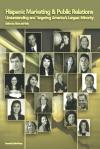
“A must resource for practitioners/professionals expecting to reach US Hispanics; also valuable for college programs in marketing, public relations and communications. Highly recommended.”
Choice magazine
Click here for information on the Hispanic Marketing & Public Relations books
Posted by Elena del Valle on August 21, 2008
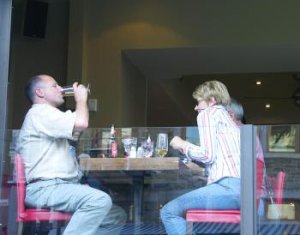
Photo: FreePhotosBank.com
Latinos health care access and health care information access differs in some ways from the general population. Although many Latinos lack health care providers and have had limited access to health care information in the past year; more than eight in ten respondents to a recent telephone survey rely on media and other sources for health care information, according to a Pew Hispanic Center report released earlier this month.
Latinos rely heavily on the health care information they access through media sources and 79 percent of respondents said they act on this information. This indicates media and social networks are powerful resources to reach America’s Latino population.
Although many Latinos (71 percent) said they received information from a doctor in the past year, an equal proportion indicated their source of health information was social networks such as family, friends, church groups and community groups. And 83 percent said they obtained health information from the media, especially television.
Hispanic Marketing and Public Relations Understanding and Targeting America’s Largest Minority book

“A must resource for practitioners/professionals expecting to reach US Hispanics; also valuable for college programs in marketing, public relations and communications. Highly recommended.”
Choice magazine
Click here for information on the Hispanic Marketing & Public Relations books
The researchers concluded that Hispanic men, youth and the less educated were the least likely to have a regular health care provider. This is similar to the demographic pattern present among non Hispanic whites who also lack a health care provider. Spanish dominant, less acculturated Latinos who have been in the United States a short time or are foreign citizens are more likely to report a lack of health care access.
At the same time, many Latinos who responded to the survey saying they have no regular place they visit for medical care are high school graduates (50 percent), United States born (30 percent) and have health insurance (45 percent). Many indicated they don’t have a health care provider because they are rarely ill.
The report, based on a nationally representative bilingual telephone survey of 4,013 Hispanic adults, was conducted between July 16, 2007 and September 23, 2007. It was written by Gretchen Livingston, senior researcher, and Susan Minushkin, deputy director, of the Pew Hispanic Center, and D’Vera Cohn, senior writer, Pew Research Center. They also examined Latino knowledge of diabetes issues and conducted the report in conjunction with the Robert Wood Johnson Foundation.
The Pew Hispanic Center, an initiative of the Pew Research Center, is a non-partisan, non-advocacy research organization based in Washington, D.C. The Pew Hispanic Center is funded by The Pew Charitable Trusts.
Target Latinos effectively by anticipating changes in the market with
“Hispanic Projections with 2007-08 update” audio recording

Presenter Roger Selbert, Ph.D.
Find out
- About Latino buying power growth in the future
- How Latino market growth compares with other markets in the U.S.
- What drives the rise of Latino economic clout
- Who should target the Latino market
- What is the size of the Hispanic affluent market
- If the luxury Latino market is growing
Stay ahead of your competition with “Hispanic Projections”
Posted by Elena del Valle on August 20, 2008
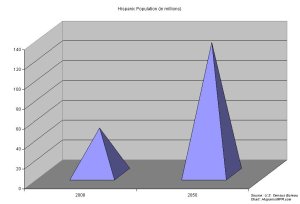
Hispanic population projections – click on image to enlarge
According to the latest U.S. Census data, black, Hispanic, and Asians under 20 years of age represent the majority or are near the majority in one of every four counties in the United States. Put another way, racial and ethnic minorities represent 43 percent of Americans under 20.
According to the U.S. Census Bureau, more than half the population in almost one in every 10 of the country’s 3,141 counties is majority minority, meaning more than half the residents in that area belong to a minority group.
As of July 2007, Hispanics were the majority in 46 counties. All of the counties, save Seward, Kansas and Bronx, New York were in the South or the West, specifically Florida, Texas, Arizona, California, New Mexico and Washington.
Target Latinos effectively by anticipating changes in the market with
“Hispanic Projections with 2007-08 update” audio recording

Presenter Roger Selbert, Ph.D.
Find out
- About Latino buying power growth in the future
- How Latino market growth compares with other markets in the U.S.
- What drives the rise of Latino economic clout
- Who should target the Latino market
- What is the size of the Hispanic affluent market
- If the luxury Latino market is growing
Stay ahead of your competition with “Hispanic Projections”
At the same time, the Hispanic population is projected to nearly triple, from 6.7 million to 132.8 million during the 2008-2050 period. Its share of the nation’s total population is projected to double, from 15 percent to 30 percent. If that happens nearly one in three U.S. residents would be Hispanic.
Although population changes from July 1, 2007 were minor the update confirms the importance of America’s minorities which now represent one third of the overall population. Some speculate the aggregate of these market segments may constitute more than half of the population sooner than the date estimated by census staff, 2050. The population of the United States as of this writing is 304,870,304.
Find out what multicultural kids across America think
Listen to Michele Valdovinos, SVP, Phoenix Multicultural in
“Marketing to Multicultural Kids” audio recording

Michele Valdovinos gives a presentation and participates in an extended Q&A discussion about multicultural children based on a Phoenix Multicultural and Nickelodeon study of 1,300 multicultural children in 16 United States markets.
Find out about
• The Phoenix Multicultural Kids Study
• Relationship between children and their context
• Issues relating to family, technology and media, diversity, buying power, relationships in household, self perception, values, acculturation, cultural heritage, frequency of media activity, income and spending, brand preferences, the American Dream
• How many billions of dollars buying power multicultural kids children have
• Children’s spending attitudes, habits by ethnicity
• How much money a year Hispanic kids have available to spend
• Types of products Hispanic kids buy
Click here for information on “Marketing to Multicultural Kids” audio recording
Posted by Elena del Valle on August 13, 2008

Scene from “Transformation” ad
Photos: Gallegos Group
From February 18 to June 30 of this year Foster Farms targeted Latino consumers with a video ad campaign that appeared in California media outlets. It took seven staff members at Grupo Gallegos 10 weeks to produce the commercial which aired in Los Angeles, San Francisco, Oakland, San Jose, Sacramento, Stockton, Modesto, Fresno, San Diego, Bakersfield, Monterey and Salinas.
The “Transformation” spot parodies last year’s, Dove “Evolution.” It features the Foster Imposters, one enduring hours in a director’s chair being primped and pampered by the other, trying to pass as fresh and natural chickens. The commercial, produced for television, won the agency a Belding Bowl Award. According to promotional materials it is the only Belding Bowl awarded to an agency targeting the United States Hispanic market, and one of only five agencies awarded for their work in television.
Make your ads resonate with Hispanics
Listen to C&R’s Research Director Liria Barbosa in
“Hispanics’ Perspective on Advertising” audio recording

Liria Barbosa gives a presentation and participates in an extended Q&A discussion about
• Type of ads Latinos prefer
• Latino top media choices
• Percent of Latinos who tried products because of ads
• Percent of Latinos who purchased products because of ads
• What makes an ad “Hispanic”
• If ad language is important for bicultural Latinos
• What to keep in mind when targeting bicultural Latinos with ads
Click here for information on Hispanic Perspectives on Advertising
“We are extremely honored to be recognized by The Belding Awards for our work with Foster Farms, which speaks directly to the personalities, views, and culture of the Hispanic population,” said John Gallegos, chief executive officer, Grupo Gallegos. “We believe the award validates our partners at Foster Farm’s commitment to telling their story in an entertaining yet effective way. We look forward to continuing to produce award-winning work with our client.”
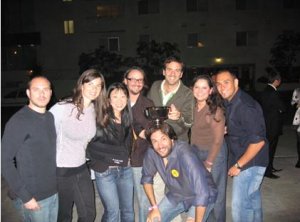
Foster Farm ad team members: Brian De La Peña, Valeria Maldini, Chi Yoon, Martin Cerri, Carlos Barciela, Nora Ayala, Albert Recinos and Favio Ucedo (bottom row)
The ads aired on Univision, Telefutura, Telemundo and some independent stations: KRCA, KAZA and KWHY in Los Angeles and XEWT in San Diego. Agency representatives declined to share budget information or a video of the ad for this article.
The Belding Awards recognize the best work in television, print, interactive and radio; of advertising conceived and created in Southern California. An independent advertising firm specializing in the U.S. Hispanic market, Grupo Gallegos is located in Long Beach, California. Agency clients include Target, Energizer, Fruit of the Loom, Comcast, The California Milk Processor Board, and Valvoline.
Foster Farms is one of largest poultry sellers in the Western United States. The company has been accused by an East Bay Animal Advocates website of failing to provide proper care for chickens.
Posted by Elena del Valle on August 7, 2008
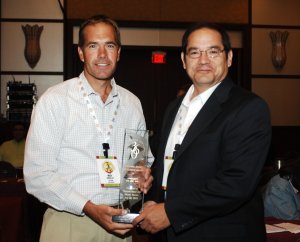
Pat Hensley and Jose Amaya accepted the award for Hy-Vee
Photos: Nielsen
Some 360 marketers from across the nation gathered in Miami, Florida last week to discuss the latest trends in the Hispanic retail industry. Nielsen Business Media, the conference organizer, took advantage of the gathering to recognize retailers. Six retailers in five categories received 2008 Hispanic Retail Excellence Awards: 7-Eleven, Jewel/Osco, Hy-Vee, Longs Drugs, Target, and Best Buy during the fourth annual Hispanic Retail 360 summit, held July 28-30 in Miami.
Conference representatives presented the Mass Retail award to Target Stores; the Grocery award to Jewel/Osco and Hy-Vee (tie); Convenience Stores to 7-Eleven; Drug Stores to Longs Drugs and Specialty Retail to Best Buy.
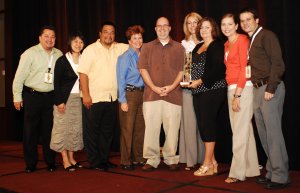
Representatives from Best Buy accept their award
The awards, based on a poll of more than 1,000 Hispanic-focused retailer and supplier executives, including members of conference’s 22-company Retailer Advisory Board, are designed to recognize leadership among retailers targeting the growing Latino population.
Poll recipients were asked to write in the name of the retailer in each of six classifications (Drug Stores, Convenience Stores, Grocery, Mass Retail, Specialty Stores and Department Stores) that “has done the most in the past year to win the hearts, minds and spending dollars of Hispanic consumers.” There were 100 responses to the poll and 12 companies received votes.
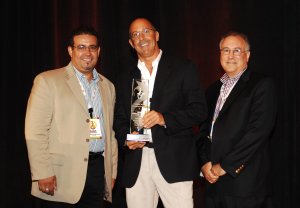
Roger Gonzalez of AARP, Mark Banister of Longs Drug, and Don Longo with Nielsen
The Advisory Board, representing retailers with more than 42,000 stores and more than $190 billion in annual revenue, also heavily influenced the content of the conference program. The board includes retailers from varied channels of retailing and food service such as ExxonMobil, Giant Eagle, McDonald’s Corp., Minyards, SuperValu, and Winn-Dixie.
Last year’s winner of the Hispanic Retail Excellence Award was Phoenix-based Bashas’ Food City. The 2006 winner was Anaheim-based JAX Markets and the 2005 winner was Pros Ranch Market, which operates Hispanic market stores in southern California and four in Phoenix, Arizona. Hispanic Retail 360 is produced by Progressive Grocer and Convenience Store News, two media brands owned by Nielsen Business Media.
“Best in Class Hispanic Strategies” audio recording


Presenters Carlos Santiago and Derene Allen
-
Find out what makes 25 percent of the top 500 Hispanic market advertisers out perform the remaining companies
-
Discover what questions to ask, steps to take to be a Best in Class company
Click here for more about “Best in Class Hispanic Strategies” audio recording





































